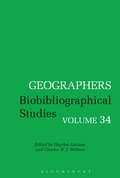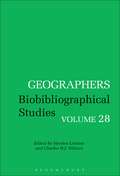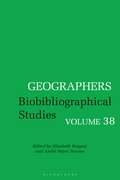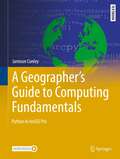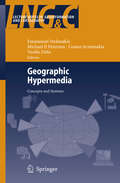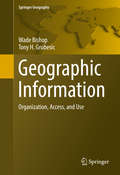- Table View
- List View
Geographers: Biobibliographical Studies, Volume 34 (Geographers #26)
by Hayden Lorimer Charles W. J. WithersVolume 34 of Geographers: Biobibliographical Studies features eight essays that together demonstrate geographers' diverse scholarly engagement with the practise of their subject. There are two physical geographers (a Frenchman and an Englishman, both geomorphologists), a British historical geographer, a French colonial geographer, a Russian explorer-naturalist of Central Asia and Tibet, a British-born but long-time Australian resident and scholar of India, Pakistan, and the Pacific world, an American regionalist and eugenicist, and a Scots-born long-time American resident, one of the world's leading Marxist geographers and urban theorists. Equally but differently committed to geography's many specialisms, these subjects wonderfully illuminate the vibrancy – and the contradictions – behind the living of geographical lives.
Geographers: Biobibliographical Studies, Volume 13 (Geographers)
by Geoffrey MartinGeographers is an annual collection of studies on individuals who have made major contributions to the development of geography and geographical thought. Subjects are drawn from all periods and from all parts of the world, and include famous names as well as those less well known, including explorers, independent thinkers and scholars. Each paper describes the geographer's education, life and work and discusses their influence and spread of academic ideas. Each study includes a select bibliography and a brief chronology. The work includes a general index, and a cumulative index of geographers listed in volumes published to date. Published under the auspices of the International Geographical Union.
Geographers: Biobibliographical Studies, Volume 14 (Geographers)
by Geoffrey MartinGeographers is an annual collection of studies on individuals who have made major contributions to the development of geography and geographical thought. Subjects are drawn from all periods and from all parts of the world, and include famous names as well as those less well known, including explorers, independent thinkers and scholars. Each paper describes the geographer's education, life and work and discusses their influence and spread of academic ideas. Each study includes a select bibliography and a brief chronology. The work includes a general index, and a cumulative index of geographers listed in volumes published to date. Published under the auspices of the International Geographical Union.
Geographers: Biobibliographical Studies, Volume 15 (Geographers)
by Geoffrey MartinGeographers is an annual collection of studies on individuals who have made major contributions to the development of geography and geographical thought. Subjects are drawn from all periods and from all parts of the world, and include famous names as well as those less well known, including explorers, independent thinkers and scholars. Each paper describes the geographer's education, life and work and discusses their influence and spread of academic ideas. Each study includes a select bibliography and a brief chronology. The work includes a general index, and a cumulative index of geographers listed in volumes published to date. Published under the auspices of the International Geographical Union.
Geographers: Biobibliographical Studies, Volume 16 (Geographers)
by Geoffrey MartinGeographers is an annual collection of studies on individuals who have made major contributions to the development of geography and geographical thought. Subjects are drawn from all periods and from all parts of the world, and include famous names as well as those less well known, including explorers, independent thinkers and scholars. Each paper describes the geographer's education, life and work and discusses their influence and spread of academic ideas. Each study includes a select bibliography and a brief chronology. The work includes a general index, and a cumulative index of geographers listed in volumes published to date. Published under the auspices of the International Geographical Union.
Geographers: Biobibliographical Studies, Volume 13 (Geographers)
by Geoffrey MartinGeographers is an annual collection of studies on individuals who have made major contributions to the development of geography and geographical thought. Subjects are drawn from all periods and from all parts of the world, and include famous names as well as those less well known, including explorers, independent thinkers and scholars. Each paper describes the geographer's education, life and work and discusses their influence and spread of academic ideas. Each study includes a select bibliography and a brief chronology. The work includes a general index, and a cumulative index of geographers listed in volumes published to date. Published under the auspices of the International Geographical Union.
Geographers: Biobibliographical Studies, Volume 14 (Geographers)
by Geoffrey MartinGeographers is an annual collection of studies on individuals who have made major contributions to the development of geography and geographical thought. Subjects are drawn from all periods and from all parts of the world, and include famous names as well as those less well known, including explorers, independent thinkers and scholars. Each paper describes the geographer's education, life and work and discusses their influence and spread of academic ideas. Each study includes a select bibliography and a brief chronology. The work includes a general index, and a cumulative index of geographers listed in volumes published to date. Published under the auspices of the International Geographical Union.
Geographers: Biobibliographical Studies, Volume 15 (Geographers)
by Geoffrey MartinGeographers is an annual collection of studies on individuals who have made major contributions to the development of geography and geographical thought. Subjects are drawn from all periods and from all parts of the world, and include famous names as well as those less well known, including explorers, independent thinkers and scholars. Each paper describes the geographer's education, life and work and discusses their influence and spread of academic ideas. Each study includes a select bibliography and a brief chronology. The work includes a general index, and a cumulative index of geographers listed in volumes published to date. Published under the auspices of the International Geographical Union.
Geographers: Biobibliographical Studies, Volume 16 (Geographers)
by Geoffrey MartinGeographers is an annual collection of studies on individuals who have made major contributions to the development of geography and geographical thought. Subjects are drawn from all periods and from all parts of the world, and include famous names as well as those less well known, including explorers, independent thinkers and scholars. Each paper describes the geographer's education, life and work and discusses their influence and spread of academic ideas. Each study includes a select bibliography and a brief chronology. The work includes a general index, and a cumulative index of geographers listed in volumes published to date. Published under the auspices of the International Geographical Union.
Geographers: Biobibliographical Studies, Volume 27 (Geographers)
by Charles W. Withers Hayden LorimerThe twenty-seventh volume of Geographers: Biobibliographical Studies includes essays covering the geographical work and lasting significance of eight individuals between the late sixteenth century and the early twentieth century. The essays cover early modern geography, cartography and astronomy, geography's connections with late Renaissance humanism and religious politics, 'armchair geography' and textual enquiry in African geography, medical mapping and Siberian travel, human ecology in the Vidalian tradition, radical political geography in twentieth-century USA, American agricultural geography and cultural-historical geography in Japan and in India. In these essays, GBS continues to provide detailed insight into the richness of geography's intellectual traditions and the diversity of geographers' lives.
Geographers: Biobibliographical Studies, Volume 28 (Geographers)
by Charles W. Withers Hayden LorimerThe Geographers Bio-bibliographical Series Volume 28 includes essays on Dick Chorley, the influential geomorphologist, Charles P. Daly, long-serving president of the American Geographical Society, Marion Newbigin, one of the leading women geographers of the early twentieth century and Peter Heyleyn, early modern humanist, historian and geographical author.
Geographers: Biobibliographical Studies, Volume 26 (Geographers)
by Charles W. Withers Hayden LorimerThis twenty-sixth volume of Geographers: Biobibliographical Studies brings together essays on leading figures in time geography and regional theory, on GIS, on regional, cultural and political geography, on scriptural geography, historical geography and methodology, and on African exploration. Each essay engages with the individual's contribution to geography, their works and their lives and the intellectual and social contexts in which they worked and which helped shape them. In addition - and to mark the new co-editorial pairing leading the series - the volume has an essay on the history of GBS, on the importance of biographical work in the history of geography and on issues to be addressed by the scholarly communities engaged in promoting this vital area of geographical research.
Geographers: Biobibliographical Studies, Volume 27 (Geographers)
by Charles W. Withers Hayden LorimerThe twenty-seventh volume of Geographers: Biobibliographical Studies includes essays covering the geographical work and lasting significance of eight individuals between the late sixteenth century and the early twentieth century. The essays cover early modern geography, cartography and astronomy, geography's connections with late Renaissance humanism and religious politics, 'armchair geography' and textual enquiry in African geography, medical mapping and Siberian travel, human ecology in the Vidalian tradition, radical political geography in twentieth-century USA, American agricultural geography and cultural-historical geography in Japan and in India. In these essays, GBS continues to provide detailed insight into the richness of geography's intellectual traditions and the diversity of geographers' lives.
Geographers: Biobibliographical Studies, Volume 26 (Geographers #Volume 26)
by Charles W. Withers Hayden LorimerThis twenty-sixth volume of Geographers: Biobibliographical Studies brings together essays on leading figures in time geography and regional theory, on GIS, on regional, cultural and political geography, on scriptural geography, historical geography and methodology, and on African exploration. Each essay engages with the individual's contribution to geography, their works and their lives and the intellectual and social contexts in which they worked and which helped shape them. In addition - and to mark the new co-editorial pairing leading the series - the volume has an essay on the history of GBS, on the importance of biographical work in the history of geography and on issues to be addressed by the scholarly communities engaged in promoting this vital area of geographical research.
Geographers: Biobibliographical Studies, Volume 28 (Geographers)
by Charles W. Withers Hayden LorimerThe Geographers Bio-bibliographical Series Volume 28 includes essays on Dick Chorley, the influential geomorphologist, Charles P. Daly, long-serving president of the American Geographical Society, Marion Newbigin, one of the leading women geographers of the early twentieth century and Peter Heyleyn, early modern humanist, historian and geographical author.
Geographers: Biobibliographical Studies, Volume 38 (Geographers)
Women are the exclusive focus of the 38th volume of Geographers. For the first time in the serial's history, the entire volume is devoted to important work of distinguished female geographers, amply demonstrating how these scholars' professional lives enrich the discipline's history. It also illustrates how reading and writing their biographies not only expands our understanding of geography's past, but points to its more diverse future.The collection includes biographies of Doreen Massey, winner of geography's 'Nobel prize', the prix Vautrin-Lud, for her remarkable contribution to geography and neighbouring disciplines which discovered the importance of space through her work; Helen Wallis, geographer and historian of cartography who for many years had charge of the UK's foremost collection of maps; Alice Saunier-Seïté, who applied her geographical training and formidable energy to teaching and educational reform in France; Isabel Margarida André, who lived through a turbulent political period in her native Portugal and meticulously investigated its effect on women and political geography; and the many women who helped to create the UK's first Geography department - the University of Oxford's, School of Geography - including Fanny Herbertson, Nora MacMunn, Marjorie Sweeting, Mary Marshall, Barbara Kennedy and other women geographers who are memorialised in a group article.
A Geographer's Guide to Computing Fundamentals: Python in ArcGIS Pro (Springer Textbooks in Earth Sciences, Geography and Environment)
by Jamison ConleyThis upper-undergraduate textbook teaches students programming in GIS using a mix of computer science theory and hands-on activities, with the aim of empowering students to understand fundamentals and apply their knowledge beyond the specific examples in the book. Each of the book’s twenty-one chapters integrates instructional material with exercises in ArcGIS Pro. In doing so, this book combines the strengths of workbooks and theoretical textbooks to provide a holistic and comprehensive text. Each chapter concludes with an unguided task that ensures students have learned the broader principles explained therein. In addition to its unique format, the book covers oft-neglected topics such as debugging, creating a program from scratch, and managing metadata. Section I starts with the principles of scripting and programming with Python. Section II introduces the ArcPy module and elements specific to ArcGIS Pro. This section focuses on data structures, and how they are used and implemented within Python. Section III uses the topic of algorithms to guide the student through creating tools to add functionality to ArcGIS Pro. The last section, Section IV, builds upon section III to guide the student to developing and sharing projects and Python packages to include external open-source code and share the Python code as an open-source package. This text will prepare students for a long-term ability to do GIS programming, whether in industry or academic research. This comes from the author’s observations of students who have learned GIS programming in one platform, such as VBA in ArcMap, struggle to apply that knowledge to a new platform, such as Python in ArcGIS Pro, because the content was presented too closely with a specific platform. The integration of exercises with conceptual content, along with the choice of chapter content, serves this goal of preparing students for working in a dynamic, rapidly changing technology field.
Geographic Data Analysis Using R
by Xindong HeThis book is structured to encompass both the foundational and specialized aspects of quantitative analysis in geography. The basic content covers descriptive statistical analysis and correlation analysis of geographical data, while the professional content delves into more advanced topics like linear regression analysis, geographically weighted regression analysis, time series analysis, cluster analysis, principal component analysis, Markov chain analysis, and geographical network analysis. The methodologies span from widely utilized techniques to more recent developments, and the data primarily originates from reputable sources in China. The example code provided in the book can be executed using R packages available on the CRAN website.This book is an invaluable resource for undergraduate and graduate students, as well as researchers interested in learning and applying R for processing, visualizing, and analyzing geographic data. It serves as an introductory course in quantitative methods in geography for students in geography departments. Additionally, it is an ideal supplementary text for applied methods courses across various disciplines that involve geographic data, such as human and physical geography, geographic information science, ecology, public health, crime, and economics.
Geographic Data Science with Python (Chapman & Hall/CRC Texts in Statistical Science)
by Sergio Rey Dani Arribas-Bel Levi John WolfThis book provides the tools, the methods, and the theory to meet the challenges of contemporary data science applied to geographic problems and data. In the new world of pervasive, large, frequent, and rapid data, there are new opportunities to understand and analyze the role of geography in everyday life. Geographic Data Science with Python introduces a new way of thinking about analysis, by using geographical and computational reasoning, it shows the reader how to unlock new insights hidden within data. Key Features: ● Showcases the excellent data science environment in Python. ● Provides examples for readers to replicate, adapt, extend, and improve. ● Covers the crucial knowledge needed by geographic data scientists. It presents concepts in a far more geographic way than competing textbooks, covering spatial data, mapping, and spatial statistics whilst covering concepts, such as clusters and outliers, as geographic concepts. Intended for data scientists, GIScientists, and geographers, the material provided in this book is of interest due to the manner in which it presents geospatial data, methods, tools, and practices in this new field.
Geographic Data Science with Python (Chapman & Hall/CRC Texts in Statistical Science)
by Sergio Rey Dani Arribas-Bel Levi John WolfThis book provides the tools, the methods, and the theory to meet the challenges of contemporary data science applied to geographic problems and data. In the new world of pervasive, large, frequent, and rapid data, there are new opportunities to understand and analyze the role of geography in everyday life. Geographic Data Science with Python introduces a new way of thinking about analysis, by using geographical and computational reasoning, it shows the reader how to unlock new insights hidden within data. Key Features: ● Showcases the excellent data science environment in Python. ● Provides examples for readers to replicate, adapt, extend, and improve. ● Covers the crucial knowledge needed by geographic data scientists. It presents concepts in a far more geographic way than competing textbooks, covering spatial data, mapping, and spatial statistics whilst covering concepts, such as clusters and outliers, as geographic concepts. Intended for data scientists, GIScientists, and geographers, the material provided in this book is of interest due to the manner in which it presents geospatial data, methods, tools, and practices in this new field.
Geographic Data Science with R: Visualizing and Analyzing Environmental Change (Chapman & Hall/CRC Data Science Series)
by Michael C. WimberlyThe burgeoning field of data science has provided a wealth of techniques for analysing large and complex geospatial datasets, including descriptive, explanatory, and predictive analytics. However, applying these methods is just one part of the overall process of geographic data science. Other critical steps include screening for suspect data values, handling missing data, harmonizing data from multiple sources, summarizing the data, and visualizing data and analysis results. Although there are many books available on statistical and machine learning methods, few encompass the broader topic of scientific workflows for geospatial data processing and analysis. The purpose of Geographic Data Science with R is to fill this gap by providing a series of tutorials aimed at teaching good practices for using geospatial data to address problems in environmental geography. It is based on the R language and environment, which currently provides the best option for working with diverse spatial and non-spatial data in a single platform. Fundamental techniques for processing and visualizing tabular, vector, and raster data are introduced through a series of practical examples followed by case studies that combine multiple types of data to address more complex problems. The book will have a broad audience. Both students and professionals can use it as a workbook to learn high-level techniques for geospatial data processing and analysis with R. It is also suitable as a textbook. Although not intended to provide a comprehensive introduction to R, it is designed to be accessible to readers who have at least some knowledge of coding but little to no experience with R. Key Features: Focus on developing practical workflows for processing and integrating multiple sources of geospatial data in R Example-based approach that teaches R programming and data science concepts through real-world applications related to climate, land cover and land use, and natural hazards. Consistent use of tidyverse packages for tabular data manipulation and visualization. Strong focus on analysing continuous and categorical raster datasets using the new terra package Organized so that each chapter builds on the topics and techniques covered in the preceding chapters Can be used for self-study or as the textbook for a geospatial science course.
Geographic Data Science with R: Visualizing and Analyzing Environmental Change (Chapman & Hall/CRC Data Science Series)
by Michael C. WimberlyThe burgeoning field of data science has provided a wealth of techniques for analysing large and complex geospatial datasets, including descriptive, explanatory, and predictive analytics. However, applying these methods is just one part of the overall process of geographic data science. Other critical steps include screening for suspect data values, handling missing data, harmonizing data from multiple sources, summarizing the data, and visualizing data and analysis results. Although there are many books available on statistical and machine learning methods, few encompass the broader topic of scientific workflows for geospatial data processing and analysis. The purpose of Geographic Data Science with R is to fill this gap by providing a series of tutorials aimed at teaching good practices for using geospatial data to address problems in environmental geography. It is based on the R language and environment, which currently provides the best option for working with diverse spatial and non-spatial data in a single platform. Fundamental techniques for processing and visualizing tabular, vector, and raster data are introduced through a series of practical examples followed by case studies that combine multiple types of data to address more complex problems. The book will have a broad audience. Both students and professionals can use it as a workbook to learn high-level techniques for geospatial data processing and analysis with R. It is also suitable as a textbook. Although not intended to provide a comprehensive introduction to R, it is designed to be accessible to readers who have at least some knowledge of coding but little to no experience with R. Key Features: Focus on developing practical workflows for processing and integrating multiple sources of geospatial data in R Example-based approach that teaches R programming and data science concepts through real-world applications related to climate, land cover and land use, and natural hazards. Consistent use of tidyverse packages for tabular data manipulation and visualization. Strong focus on analysing continuous and categorical raster datasets using the new terra package Organized so that each chapter builds on the topics and techniques covered in the preceding chapters Can be used for self-study or as the textbook for a geospatial science course.
Geographic Hypermedia: Concepts and Systems (Lecture Notes in Geoinformation and Cartography)
by Emmanuel Stefanakis Michael P. Peterson Costas Armenakis Vasilis DelisThe book serves as a collection of multi-disciplinary contributions related to Geographic Hypermedia and highlights the technological aspects of GIS. Specifically, it focuses on its database and database management system. The methodologies for modeling and handling geographic data are described. It presents the novel models, methods and tools applied in Spatial Decision Support paradigm.
Geographic Information: Organization, Access, and Use (Springer Geography)
by Wade Bishop Tony H. GrubesicThe history and future of geographic information (GI) in the context of big data creates new avenues of concern over its organization, access and use. In this book the authors explore both the background and present challenges facing the preservation of GI, focusing on the roles of librarians, archivists, data scientists, and other information professionals in the creation of GI records for its organization, access, and use.
Geographic Information Analysis
by David O'Sullivan David UnwinClear, up-to-date coverage of methods for analyzing geographical information in a GIS context Geographic Information Analysis, Second Edition is fully updated to keep pace with the most recent developments of spatial analysis in a geographic information systems (GIS) environment. Still focusing on the universal aspects of this science, this revised edition includes new coverage on geovisualization and mapping as well as recent developments using local statistics. Building on the fundamentals, this book explores such key concepts as spatial processes, point patterns, and autocorrelation in area data, as well as in continuous fields. Also addressed are methods for combining maps and performing computationally intensive analysis. New chapters tackle mapping, geovisualization, and local statistics, including the Moran Scatterplot and Geographically Weighted Regression (GWR). An appendix provides a primer on linear algebra using matrices. Complete with chapter objectives, summaries, "thought exercises," explanatory diagrams, and a chapter-by-chapter bibliography, Geographic Information Analysis is a practical book for students, as well as a valuable resource for researchers and professionals in the industry.
